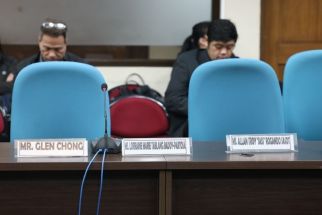DOH says no dengue "calamity"
August 12, 2005 | 12:00am
If the requirements of the Department of Health are to be strictly followed, Cebu City cannot be declared under a state of calamity with the present number of dengue cases.
Enrique Tayag, director of the DOH National Epidemiology Center, spoke before the city council yesterday afternoon and said that Cebu City is only on "alert threshold", defined as having exceeded the usual number of dengue cases but not reaching epidemic proportion.
"Cebu City does not have an epidemic but just on the alarm state," Tayag said, although he added what is alarming in Cebu and the region is that there are more deaths this year compared to last year vis-à-vis the number of those affected by the virus.
This, Tayag further explained, might either be because the virus carried by the mosquitoes here is a severe strain; or Quezon City, which also has many dengue cases, has better treatment facilities. Last year, Cebu had 937 cases and seven deaths but this year, 19 deaths have so far been reported outside the 685 affected individuals.
Under DOH standards, an area can be declared under the state of calamity if 20 percent of its population is affected by circumstance. In Cebu, 20 percent is equivalent to around 140,000 affected residents.
Based on records, Tayag said that the high rate of cases in barangays Guadalupe, Lahug and Tisa indicates these three places may have the most number of dengue breeding sites. But Tayag said he understood why the Cebu City Disaster and Coordinating Council recommended that the city be declared
under the state of calamity. This is because the Local Government Code authorizes the same as long as more than two cases are present in the area so that appropriation can be in place.
The city council got irked when several sectors insinuated that the declaration of the city under the state of calamity was done so city councilors can benefit from the calamity fund.
Tayag said the "search and destroy" strategy is still the proven and most effective way to combat dengue. This entails elimination of dengue breeding sites coupled with prevention of bites by using mosquito repellant and prompt detection of the virus.
While the city government has readied mistblowers, Tayag discouraged these as it is just another process of using insecticides, which reportedly can create "unnecessary resistance" among mosquitoes and would make the insects look for another place to breed, thus spreading the virus. He said that insecticides are necessary if there is already an extreme density of mosquitoes in an area.
He said that just a teardrop of clean and clear water would allow a dengue virus-carrying mosquito to hatch 400 larvae.
City Health Officer Fe Cabugao said she should have objected had she been in the meeting when the CCDCC recommended for the city to be declared under the state of calamity. But she said that they are not necessarily contradicting the council's decision because the city health office is one of the beneficiaries of the calamity fund that can help their campaign against dengue.
Despite Tayag's explanation of what can be declared under a state of calamity, the city council opted to stick to its declaration with Vice Mayor Michael Rama saying it is better that available funds are in place should the situation in the city worsen.
Tayag then suggested that in the future, there should be a uniform declaration between the city council and the city's health officials if ever the same situation occurs to avoid confusion and misinterpretation.
Enrique Tayag, director of the DOH National Epidemiology Center, spoke before the city council yesterday afternoon and said that Cebu City is only on "alert threshold", defined as having exceeded the usual number of dengue cases but not reaching epidemic proportion.
"Cebu City does not have an epidemic but just on the alarm state," Tayag said, although he added what is alarming in Cebu and the region is that there are more deaths this year compared to last year vis-à-vis the number of those affected by the virus.
This, Tayag further explained, might either be because the virus carried by the mosquitoes here is a severe strain; or Quezon City, which also has many dengue cases, has better treatment facilities. Last year, Cebu had 937 cases and seven deaths but this year, 19 deaths have so far been reported outside the 685 affected individuals.
Under DOH standards, an area can be declared under the state of calamity if 20 percent of its population is affected by circumstance. In Cebu, 20 percent is equivalent to around 140,000 affected residents.
Based on records, Tayag said that the high rate of cases in barangays Guadalupe, Lahug and Tisa indicates these three places may have the most number of dengue breeding sites. But Tayag said he understood why the Cebu City Disaster and Coordinating Council recommended that the city be declared
under the state of calamity. This is because the Local Government Code authorizes the same as long as more than two cases are present in the area so that appropriation can be in place.
The city council got irked when several sectors insinuated that the declaration of the city under the state of calamity was done so city councilors can benefit from the calamity fund.
Tayag said the "search and destroy" strategy is still the proven and most effective way to combat dengue. This entails elimination of dengue breeding sites coupled with prevention of bites by using mosquito repellant and prompt detection of the virus.
While the city government has readied mistblowers, Tayag discouraged these as it is just another process of using insecticides, which reportedly can create "unnecessary resistance" among mosquitoes and would make the insects look for another place to breed, thus spreading the virus. He said that insecticides are necessary if there is already an extreme density of mosquitoes in an area.
He said that just a teardrop of clean and clear water would allow a dengue virus-carrying mosquito to hatch 400 larvae.
City Health Officer Fe Cabugao said she should have objected had she been in the meeting when the CCDCC recommended for the city to be declared under the state of calamity. But she said that they are not necessarily contradicting the council's decision because the city health office is one of the beneficiaries of the calamity fund that can help their campaign against dengue.
Despite Tayag's explanation of what can be declared under a state of calamity, the city council opted to stick to its declaration with Vice Mayor Michael Rama saying it is better that available funds are in place should the situation in the city worsen.
Tayag then suggested that in the future, there should be a uniform declaration between the city council and the city's health officials if ever the same situation occurs to avoid confusion and misinterpretation.
BrandSpace Articles
<
>
- Latest
- Trending
Trending
Latest


























